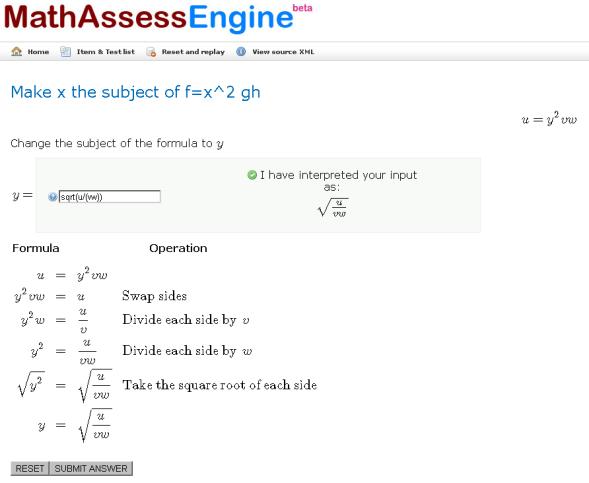Please note that this is a work in progress!
The first thing that you need to do in an assessment item, in a QTI XML file, is to declare your variables. These declarations come in 3 types – responseDeclaration, outcomeDeclaration and templateDeclaration.
responseDeclarations
This is where you declare variables used for responses and response processing. The following should be useful building blocks:
User Response
These are variables used to store the user’s response to a question.
<responseDeclaration identifier="RESPONSE_INTEGER" cardinality="single" baseType="integer"/><!-- integer response --> <responseDeclaration identifier="RESPONSE_FLOAT" cardinality="single" baseType="float"/><!-- float response --> <responseDeclaration identifier="RESPONSE_STRING" cardinality="single" baseType="string"/><!-- string response --> <responseDeclaration identifier="RESPONSE_MATHS" cardinality="record"/><!-- maths response -->
printMath
This is a variable into which Presentation MathML form of a RESPONSE expression is copied.
<responseDeclaration identifier="printMath" cardinality="single" baseType="string"/>
Hint and Solution Request
These can be set to true when the hint or solution is requested, and should be tested at the start of the responseProcessing.
<responseDeclaration identifier="HINTREQUEST" cardinality="single" baseType="boolean"/> <responseDeclaration identifier="SOLREQUEST" cardinality="single" baseType="boolean"/>
outcomeDeclarations
These are used for identifying and recording the outcomes from a user’s interactions, e.g. score and feedback.
Correct Response
These can be used to store the correct response to a question, for comparison with the user’s response.
<outcomeDeclaration identifier="iAnswer" cardinality="single" baseType="integer"/> <outcomeDeclaration identifier="mAnswer" cardinality="record"/>
Score and Feedback
<outcomeDeclaration identifier="SCORE" cardinality="single" baseType="float" normalMaximum="2">
<defaultValue>
<value>0</value>
</defaultValue>
</outcomeDeclaration>
<outcomeDeclaration identifier="FEEDBACK" cardinality="multiple" baseType="identifier"/><!-- multiple cardinality - container for multiple values. For feedback, this means we can show multiple feedback sections at once -->
<outcomeDeclaration baseType="identifier" cardinality="single" identifier="EMPTY"/><!-- Empty value, for emptying FEEDBACK container -->
Hint and Solution Related
<outcomeDeclaration baseType="boolean" cardinality="single" identifier="seenSolution">
<defaultValue>
<value>false</value>
</defaultValue>
</outcomeDeclaration>
<outcomeDeclaration baseType="boolean" cardinality="single" identifier="seenHint">
<defaultValue>
<value>false</value>
</defaultValue>
</outcomeDeclaration>
<outcomeDeclaration baseType="identifier" cardinality="single" identifier="ASKHINT">
<defaultValue>
<value>askhint</value>
</defaultValue>
</outcomeDeclaration>
<outcomeDeclaration baseType="identifier" cardinality="single" identifier="ASKSOLUTION">
<defaultValue>
<value>asksolution</value>
</defaultValue>
</outcomeDeclaration>
templateDeclarations
These are used for defining and randomising variables used in the question itself.
Template Variables
<templateDeclaration identifier="iInt" cardinality="single" baseType="integer" mathVariable="true"/><!-- Integer --> <templateDeclaration identifier="fFloat" cardinality="single" baseType="float" mathVariable="true"/><!-- Float --> <templateDeclaration identifier="sString" cardinality="single" baseType="string" mathVariable="true"/><!-- String --> <templateDeclaration identifier="mX" cardinality="record" mathVariable="true"/><!-- Maths -->
Use mathVariable=”true” to enable the variable to be used in MathML expressions.
Maxima Script Dummy Variable
<templateDeclaration identifier="tDummy" cardinality="single" baseType="boolean"/>



